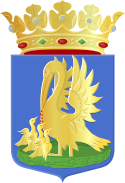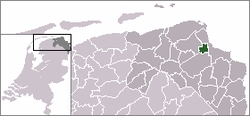Appingedam
 flag |
 coat of arms |
| province |
|
| mayor | Koos Wiersma ( CDA ; acting) |
| Seat of the municipality | Appingedam |
|
Area - land - water |
24.58 km 2 23.78 km 2 0.8 km 2 |
| CBS code | 0003 |
| Residents | 11,722 (Jan 31, 2019) |
| Population density | 477 inhabitants / km 2 |
| Coordinates | 53 ° 19 ′ N , 6 ° 51 ′ E |
| Important traffic route |
|
| prefix | 0596 |
| Postcodes | 9901-9903 |
| Website | Homepage of Appingedam |
Appingedam ( ) is a municipality and a small town in the Netherlands , province of Groningen . Appingedam has an area of about 25 km² and on January 31, 2019 had a population of 11,722.
Location and economy
The city is located a few kilometers southwest of Delfzijl on the Groningen – Delfzijl railway , the N33 federal road between Eemshaven and Hoogezand-Sappemeer and the N360 provincial road between the provincial capital Groningen and Delfzijl. The municipality is also crossed by the Emskanal and Damsterdiep canals . The latter is more like a stream because of the many curves and can only be navigated by small ships. Appingedam has a lot of small businesses. The picturesque little city center attracts more and more tourists. Many residents are commuters who work in Delfzijl. The town hall has been located in a large former school building since 1995 (the HBS; previously corresponded to a secondary school in Germany).
The East Frisian city of Aurich has been the twin town of Appingedams since September 1989 .
history
Appingedam has always been the main town of the Gaus Fivelingo , which has always tried to maintain its independence from Groningen. The city existed probably already before the year 800, but only received 1327 the city charter . This was laid down in a document that has been preserved: the so-called “Buurbrief van de Upstalboom ”. This indicates a strong influence from East Frisia .
In the 14th century the city suffered an economic setback: storm surges made it necessary to build a sea lock (zijl, German: Siel) east of the city. A new port city developed there: Delfzijl. The staple rights that Groningen acquired also contributed to the decline of Appingedam.
In the late Middle Ages, Appingedam came under the dominant influence of the chiefs (hoofdelinge) from the Snelgers family (also spelled “Snelghers”), who built the Snelgersmaborg in Appingedam. Omeko Snelgers transferred his property to Duke Albrecht of Bavaria in 1398 , who returned it to him as a fief. With this, Omeko became hostile to the city of Groningen, which would not tolerate a chief of the Ommelande placing himself under the protection of a third party. In 1400, Groningen troops devastated the Snelgersmaborg.
The castle was rebuilt in the 15th century. After its restoration, the Snelghers family lived there until 1579. The castle finally passed to the Meckama family through marriage. In 1727 it was sold and removed so that the stones could be used for other buildings.
In 1514 the city wall and the castle were so defensive that during the Saxon feud , Hugo von Leisnig, the commander of Duke Georg the Bearded's troops , decided to avoid Appingedam as a precaution. But in the further course of the 16th century, the city of Groningen, whose pressure on the cities of the Ommelande grew stronger, finally forced the demolition of the city wall.
Only when shipping flourished in the 19th century and a railway was built on the Groningen – Appingedam – Delfzijl line did the situation improve. Among other things, a ship engine factory known throughout the Netherlands (Brons company) was established there.
politics
At the end of 2017, the municipal councils of Delfzijl , Appingedam and Loppersum discussed the merger of the municipalities. They are working towards a merger on January 1, 2021.
Distribution of seats in the municipal council
The municipal council has been formed as follows since 2006:
| Political party | Seats | |||
|---|---|---|---|---|
| 2006 | 2010 | 2014 | 2018 | |
| Gemeentebelangen Appingedam | 3 | 5 | 5 | 6th |
| SP | - | - | 3 | 3 |
| CDA | 3 | 2 | 3 | 2 |
| PvdA | 7th | 4th | 2 | 2 |
| D66 | 1 | 2 | 1 | 1 |
| ChristenUnie | - | 1 | 1 | 1 |
| VVD | 1 | 1 | 0 | 0 |
| total | 15th | 15th | 15th | 15th |
mayor
Koos Wiersma ( CDA ) has been the provisional mayor of the municipality since October 1, 2019 . His colleagues include the alderman Annalies Usmany-Dallinga (Gemeentebelangen Appingedam), Lea van der Tuin (CDA) and the municipal secretary Arend Castelein.
Attractions
- the medieval city center, which is a listed building as a whole
- the Nicolaikirche in the city center ( Nikolaikerk )
- the town hall
- the local history museum (Museum Stad Appingedam)
- the Damsterdiep
- the " hanging kitchens "
- the synagogue on Broerstraat 6
- the Jewish cemetery
- the video pavilion by Zaha Hadid in Fivelpoort
- the old lime kiln on the site of the fire station
gallery
Daughters and sons of the church
- Anne Siberdinus de Blécourt (1873–1940), lawyer and legal historian
- Rudolph Cleveringa (1894–1980), legal scholar
literature
- Art. Appingedam . In: Wiebe Jannes Formsma, Riektje Annie Luitjens-Dijkveld Stol, Adolf Pathuis: De Ommelander borgen en steenhuizen . Van Gorcum, Assen 1973, ISBN 90-232-1047-6 , pp. 49-52.
- Jan Dik: Uit de geschiedenis van Appingedam. De oude hoofdplaats van Fivelingo . Van Gorcum, Assen 1956; Reprint: Tjeenk Willink en Bouma's Boekhuis, Groningen 1976, ISBN 90-6243-007-4 .
Web links
- Website of the municipality (Dutch)
- Photos, tourism, history (Dutch)
Individual evidence
- ↑ a b Koos Wiersma ruilt burgemeesterschap Westerkwartier in voor Appingedam. In: rtvnoord.nl. RTV Noord , July 1, 2019, accessed on October 4, 2019 (Dutch).
- ↑ Bevolkingsontwikkeling; regio per maand . In: StatLine . Centraal Bureau voor de Statistiek (Dutch)
- ^ Art. Appingedam . In: Wiebe Jannes Formsma, Riektje Annie Luitjens-Dijkveld Stol, Adolf Pathuis: De Ommelander borgen en steenhuizen . Van Gorcum, Assen 1973, pp. 49-52, here p. 49.
- ^ Art. Appingedam . In: Wiebe Jannes Formsma, Riektje Annie Luitjens-Dijkveld Stol, Adolf Pathuis: De Ommelander borgen en steenhuizen . Van Gorcum, Assen 1973, pp. 49-52, here p. 51.
- ↑ Ingo Hashagen: 500 years ago: The Saxon feud . Part 2: Political changes from the Weser to West Friesland . In: Jeversches Wochenblatt , February 4, 2014 .
- ↑ Fusie Delfzijl, Appingedam en Loppersum in 2021. In: RTV Noord . January 12, 2018, accessed June 22, 2018 (Dutch).
- ↑ Result of the local elections: 2014 2018 , accessed on June 22, 2018 (Dutch)
- ↑ Allocation of seats in the municipal council: 2006 2010 2014 2018 , accessed on June 22, 2018 (Dutch)
- ^ Collegeleden Gemeente Appingedam, accessed June 22, 2018 (Dutch)









